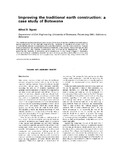Please use this identifier to cite or link to this item:
http://hdl.handle.net/10311/606Full metadata record
| DC Field | Value | Language |
|---|---|---|
| dc.contributor.author | Ngowi, A.B. | - |
| dc.date.accessioned | 2010-09-29T14:01:57Z | - |
| dc.date.available | 2010-09-29T14:01:57Z | - |
| dc.date.issued | 1997 | - |
| dc.identifier.citation | Ngowi, A.B. (1997) Improving the traditional earth construction:a case study of Botswana, Construction and Building Materials, Vol.11, No.1, pp.1-7 | en_US |
| dc.identifier.issn | 0950 0618 | - |
| dc.identifier.uri | http://hdl.handle.net/10311/606 | - |
| dc.description.abstract | The traditional developed earth as one of the most important construction materials by taking cognizance of the strength requirements, durability of resulting structures and the environmental concern in processing and using the material. Overthe years, however, modern earth construction has replaced the traditional methods. Unfortunately,these methods are also accompanied by high energy consumption and environmental degradation.This paper examines the methods of improving earth construction in two major villages in Botswana.Tests with different stabilizers showed that only certain proportions were effective and it was concluded that the traditional earth construction may be improved by using certain ratios of cement and lime as stabilizers. | en_US |
| dc.language.iso | en | en_US |
| dc.publisher | Elsevier | en_US |
| dc.subject | Earth | en_US |
| dc.subject | Stabilization | en_US |
| dc.subject | Durability | en_US |
| dc.title | Improving the traditional earth construction: a case study of Botswana | en_US |
| dc.type | Published Article | en_US |
| Appears in Collections: | Research articles (Dept of Civil Engineering) | |
Files in This Item:
| File | Description | Size | Format | |
|---|---|---|---|---|
| Ngowi_CBM_1997.pdf | Main article | 945.56 kB | Adobe PDF |  View/Open |
Items in DSpace are protected by copyright, with all rights reserved, unless otherwise indicated.
